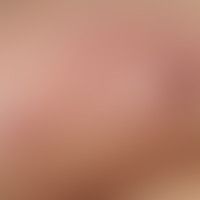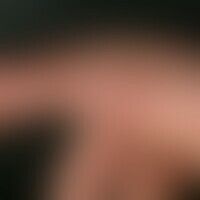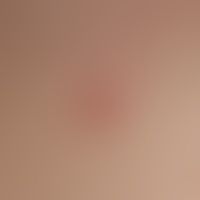Image diagnoses for "red"
877 results with 4458 images
Results forred

Psoriasis vulgaris L40.00
Psoriasis vulgaris Psoriasis palmaris with streaky and flat, reddened plaques and coarse lamellar scaly deposits.

Folliculitis profunda (overview) L01.0
Folliculitis profunda. acute, solitary, since 1 week existing, moderately sharply definable, firm, very pressure dolent, red, centrally ulcerated nodule (left mamma). distinct perilesional erythema.

Acuminate condyloma A63.0

Lymphangioma circumscriptum D18.1

Lingua plicata K14.5
Lingua plicata: unusually pronounced acquired lingua plicata with blurred leukoplakia of the train surface.

Atrophy of the skin (overview)
Atrophy of the skin due to long term internal use of glucocorticoids; skin is paper thin and easily torn.

Pityriasis rosea L42
Pityriasis rosea. truncated, díchtes maculopapular exanthema arranged in the cleft lines, little itching.

Keratosis actinica keratotic type 57.00
Keratosis actinica, keratotic type: In a 75-year-old male patient, adherent keratotic plaques have increasingly developed over the last few years, the mechanical detachment of which is painful; here flat ulcers, crusts, scars.

Rosacea papulopustulosa
Rosacea papulopustulosa: grouped, inflammatory reddened papules and pustules that persist for weeks in phases; variable feeling of tension in the facial skin.

Psoriasis palmaris et plantaris (overview) L40.3
Dry keratotic plaque type Chronically active, intermittent plaques, plaques and rhagades in a 48-year-old man, which have been present for more than 10 years, especially on the palm and fingers, multiple, rough, red, scaly, blurred and blurred spots, plaques and rhagades.

Cutaneous t-cell lymphomas C84.8
Sézary syndrome. universal redness with severe itching that has existed for several years. generalized lymphadenopathy.

Eosinophilic pustular folliculitis L73.8
Pustulosis, sterile eosinophils, moderately itching, urticarial papules and plaques, papulovesicles grouped in the middle of the forehead.

Pyoderma gangraenosum L88

Hand-foot-mouth disease B08.4
hand-foot-mouth disease: since about1 week, painful, blisters, pustules and papules on hands and feet. single aphthous lesions on palate and lip mucosa. about 2 weeks before, unspecific flu-like prodromas.

Keratosis benign lichenoid L85.91
Keratosis benigne lichenoide: Reddish plaque of about 1.0 cm on the upper side of the right mamma of a 79-year-old female patient. The patient had noticed relatively fast growth and therefore presented with malignancy. The tissue biopsy showed a lichenoid keratosis.









